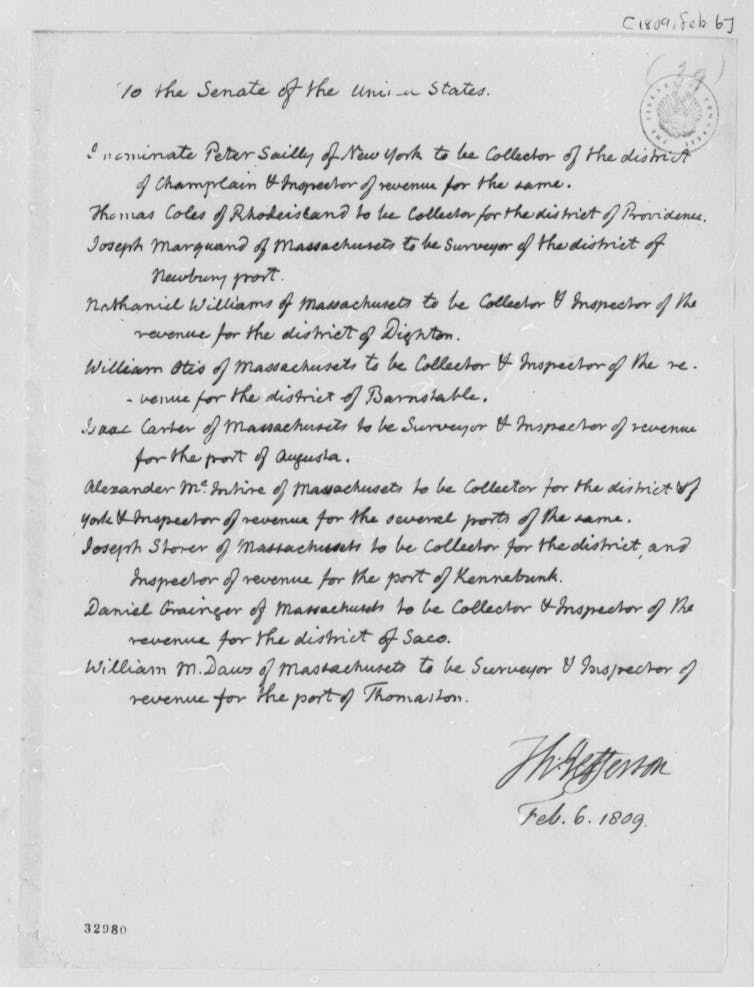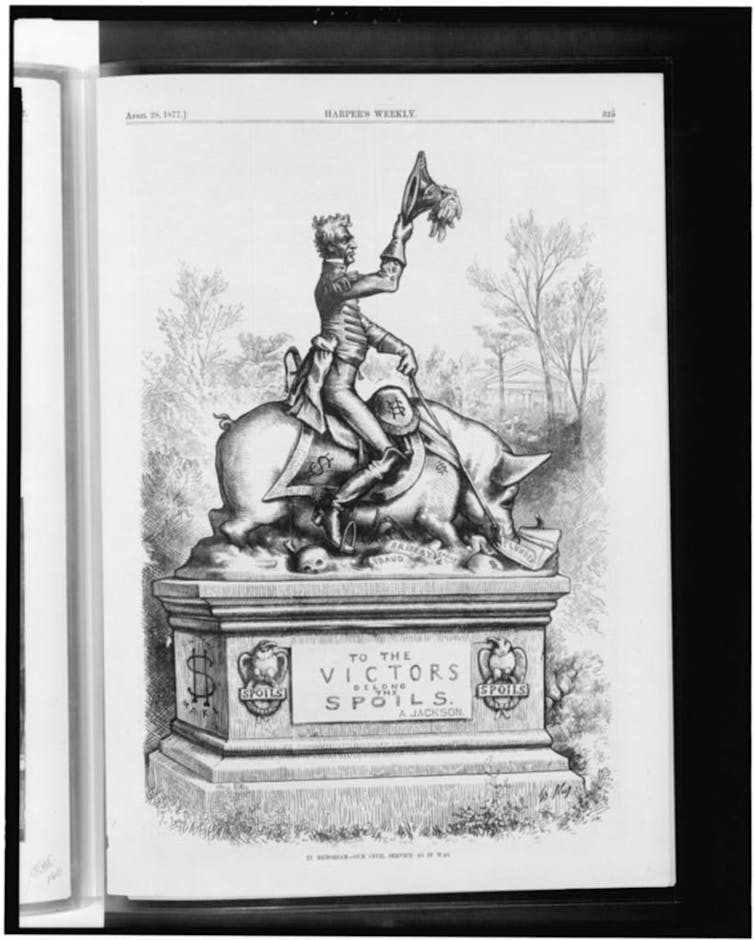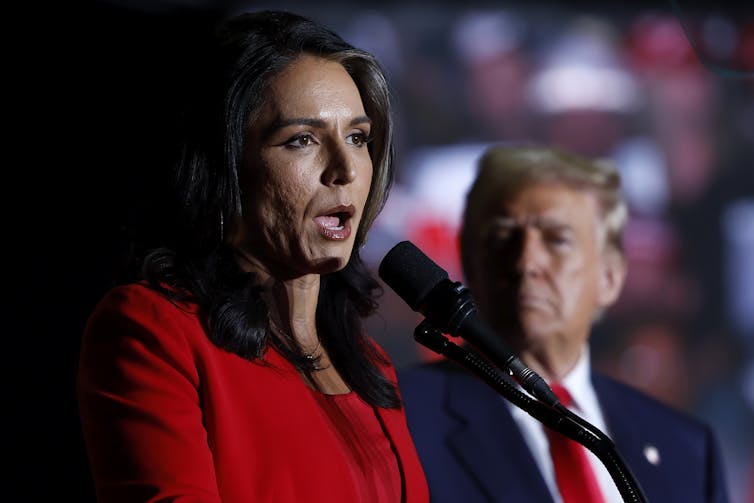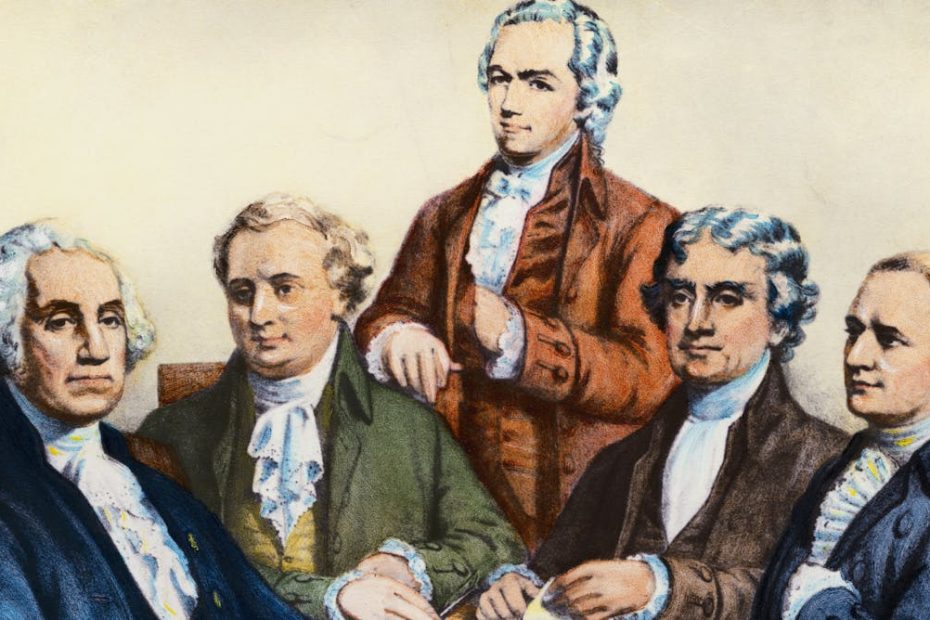Things were very different when the president sent a handwritten list of nominees to the Senate
The new U.S. Senate is about to begin its work, and one of its first tasks will be to consider Donald Trump's nomination for federal office.
Trump himself has said he would prefer recess appointments for Cabinet members. This would avoid traditional Senate confirmation hearings, which have become increasingly polarizing, drawn-out and partisan.
Discussion of the nominations included many references to the founders and the process they devised for confirming nominees.
In reality, however, the founders had little to say on the subject. The Constitution states that the president “appoints ambassadors, other ministers and consuls, justices of the Supreme Court, and all other officers of the United States, with the advice and consent of the Senate.”
That's it. The Federalist Papers, editorials and pamphlets advocating for ratification and read by many students in high schools and colleges, did not add much on the subject of federal appointments. The founders did not explore this subject in detail in their letters.

Thomas Jefferson Papers at the Library of Congress
Important functions of the Senate
I am a historian who has spent nearly two decades exploring the federal appointments process. I recently launched “The Creation of the Federal Government, 1789-1829,” a major digital project aimed at reconstructing the first decade of the federal government.
From 1789 to 1829, the Senate considered more than 5,000 nominations for federal civil offices, and I combed through early federal correspondence to understand their approach to this important function of the Senate.
The first-term president insisted that the confirmation process be open, transparent and subject to Senate oversight. The early Senate was keen to retain its power of appointment but gave the president broad discretion in establishing the executive branch.
This means that “advice and consent” is not promulgated as a formal set of rules. Rather, advice and consent are shaped in practice and emerge from the day-to-day needs of government.
The Founder’s Model: Transparent Inefficiency
America's first president, George Washington, operated under the philosophy that the president and Senate should be actively involved in approving even the lowest-level officials.
After early nominations of Thomas Jefferson, the first Secretary of State, and Alexander Hamilton, the first Secretary of the Treasury, among others, Washington personally nominated hundreds of customs collectors, junior officers in the military, and territorial officials. The first of these was on August 3, 1789, when Washington sent out a list of 139 nominees for “harbour collectors, naval officers, and surveyors.”
Washington argued that the Senate should hardly consider a single federal office. The only exceptions were clerks, postmasters, and soldiers in the army.
The Senate was smaller at the time, ranging from 22 members from 11 states in 1789 when Washington was inaugurated to 48 members from 24 states in 1829 when John Quincy Adams left office. There were no hearings and not much formal review. Instead, the Senate discusses nominations among themselves, often voting on the same day.
Appointments for recess are rare
This collaborative system is designed to reflect checks and balances. But it’s also an inefficient approach that consumes the time and energy of the president and senators.
The process was especially busy at the start of the congressional term, with the Senate Executive Gazette — the only detailed record of the Senate's early proceedings — showing that nominations went almost a week without being considered.
Washington's successors similarly sent thousands of lists to the Senate, often in their own handwriting. The Senate responded by devoting much of its daily agenda to considering these nominees.
The results tell a story: Just as the president believes the Senate must be involved in building the federal workforce, senators apparently believe the president should have broad discretion. According to my analysis, they confirmed more than 90% of the nominations received between 1789 and 1829.
This remained the case even during the first period of divided government in 1801-1802. The Federalist majority in the Senate always approved President Jefferson's nomination, even though he was from the opposing Republicans.
Jefferson initially viewed federal appointments as having considerable partisan advantages. For example, between 1801 and 1802, he deposed 146 customs officials whom he considered Federalists and eagerly sought Republicans to replace them. But Jefferson also retained many of the officials appointed by his Federalist predecessors because he valued their ability—and the stability of the system.
My research shows that these early presidents, from the 1790s to the 1820s, rarely used recess appointments. When they do, it is primarily to fill a vacancy created by death or resignation, and then they submit formal nominations quickly once the Senate returns.
Modern model: a divided system

Thomas Nast, Harper's Weekly/Library of Congress Prints and Photographs Division
In the late 1820s, the United States began to reverse this relatively constructive concession among the Founders.
When Andrew Jackson took office in 1829, he declared that the victors would receive the spoils, including appointments. He viewed appointments as rewards for political allies, regardless of their qualifications.
Jacksonian patronage became a target of progressive reformers in the late 19th century. They claim the spoils system creates a federal system that hires unqualified employees and rewards political allies rather than serving the public. They believe civil service reform will produce an effective, efficient, and nonpartisan federal government.
These reforms, coupled with a growing federal government that included too many positions for the Senate to review, set the stage for today's structure in which Senate confirmation power is reserved for higher-level positions, most of which follow It changes with each presidential administration.
The vast majority still agree

Anna Money Tree/Getty Images
Withholding advice and consent for top positions has shifted the attention of the Senate and the public entirely to high-value positions and nominees with more political experience.
Broadcasting confirmation hearings is a practice that began in the 1980s, but this only adds to the sense that hearings have become political theater. It makes the process more transparent, but also creates more opportunities for all involved to turn the hearing into political grandstanding.
However, despite these recent developments, the vast majority of nominations are still approved. This is especially true for non-cabinet and lower-level positions.
For positions such as U.S. Attorney, Assistant Secretary of State, or Bureau of Land Management Director, the president typically submits nominations to the Senate when the Senate is in session. Senate confirmations typically follow heated debates but with limited opposition.
All presidents have used interim appointments, and some have caused significant public controversy, but they are the exceptions that prove the rule.
The process of nominating candidates for these offices remains markedly linked to the early days of the Republic.
However, the rules are changing.
Trump's first administration used interim appointments more frequently than his predecessors. He may do the same thing in his second term.
Meanwhile, Senate Republicans have faced criticism for stalling nominations to key civilian and military posts during the Obama and Biden administrations.
These recent developments break with long-standing practices and radically break with how the Founding Fathers imagined the advice and consent process.
This story is part of a series of profiles explaining cabinet and senior executive positions.









